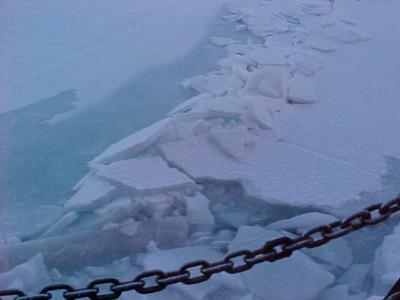19 March, 2001
Tidbit of History
St. Lawrence Island is 95 miles long, 25 miles wide and is located 130 miles
SW of Nome. The principal villages are Gambell on the west end, and Savoonga
on near mid-island. Captain James Cook, Royal Navy, passed east of the
island in 1778, and west of it in 1779. He named the eastern end "Anderson
Island" for the surgeon aboard the HMS Discovery, believing it to be a
separate island. He later found it to be part of St. Lawrence Island, but
Cook died before making corrections.
I am planning to travel by helicopter to the island with an opportunity to
visit Gambell and Savoonga communities. I will be traveling with Dr. Lee
Cooper and Gay Sheffield, biologist with Alaska Fish and Games.
Science Observations
Yesterday's journal shared information regarding Dr. Jim Lovvorn's research.
He is a professor at the University of Wyoming. One of his goals today was
to find the spectacled eider ducks. The ducks are thought to be found about
30 miles away from our current location. After several hours of helicopter
flight time, Dr.Lovvorn was able to collect his data in order to study the
health, breeding success, and life expectancy of the spectacled eider ducks.
Tonight the Northern Lights should be visible due to the clear sky. Mark
Geesey, Research Associate from the University of Charleston, SC provided me
with a nice description of this event. The sun produces parcticles which are
ejected toward the earth. The earth is surrounded by the atmospheric layer.
The earth's magnetic fields are outside the atmospheric layer and naturally
move in the direction of the north and south poles. The magnetic fields
attract the parcticles from the sun, much in the same way as metal is
attracted to a magnet. As these high energy parcticles hit the upper
atmosphere, the phenomenon known as the Northern Lights or Aurora Borealis
occurs. When the parcticles hit the lower atmosphere the phenomenon is known
as the Southern Lights or Aurora Australis.
Daily Update
It is very cold out today but with our warm clothes, most of us aren't
having a problem with the cold temperatures. The air temperature is 7 and
wind-chill is -18. There are no problems with visibility today. It is
sunny, clear, and beautiful outside. There are numerous pressure ridges
along the icy landscape. Two of the decks have been closed temporarily due
to ice on the metal and slippery conditions. The ship became stuck in the
ice for about an hour this morning. The ice isn't very thick but there is
quite a bit of snow on top of the ice. This results in difficulty with
friction between the ship and the ice. As the ship moved through the ice
slush formed. This slush got into the intake interfering with the natural
flow of cooling water. Consequently, this caused overheating in the diesel
engine. This resulted in about an hour of down time to resolve the problem.
The ice is a couple of feet deep at this point. It is packed in due to
southerly winds. We are making good speed through the ice right now. We
have experienced a problem with current resulting in drifting along the
International Date Line. Flexibility is definitely the name of the game.
The emails in and out are about to be resolved. We will have all the access
that we need tomorrow. Please send any emails to
kstevens@pacd13cutters.uscg.mil. Please don't hit reply if you send a
response back to me. The address needs to be typed into each message.
This has been a very unusual day in the sense that we were not able to do
any stations on our 12-hour watch. We thought several times that we were
going to work our station and we got dressed and prepared to be outside.
This was a major undertaking in itself. Getting dressed involves mustang
suit, mukluks, neck gaiter, balaclava, hat, hard hat, gloves, gloves, and
more gloves! One time the CTD was launched but it got too cold and needed
to be returned to the ship to thaw out. The problem involves moving the
apparatus from the enclosed garage to the outside deck sitting there too
long before entering the water resulting in freezing metal.

Changes in the ice today. <>
Contact the TEA in the field at
.
If you cannot connect through your browser, copy the
TEA's e-mail address in the "To:" line of
your favorite e-mail package.
|
